

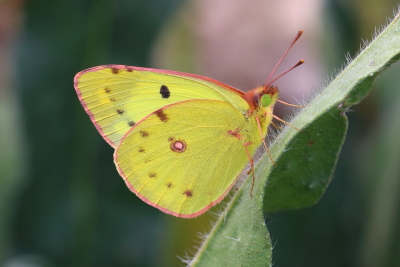
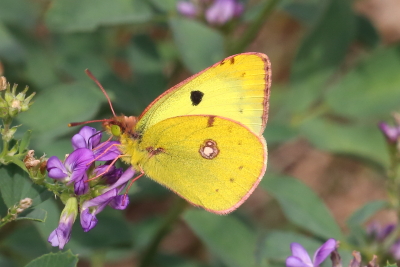
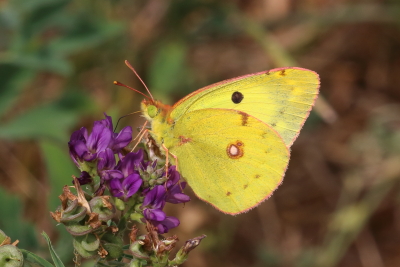
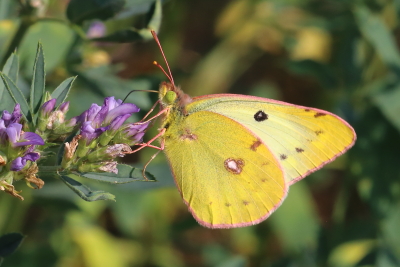
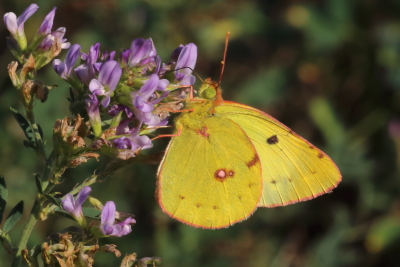
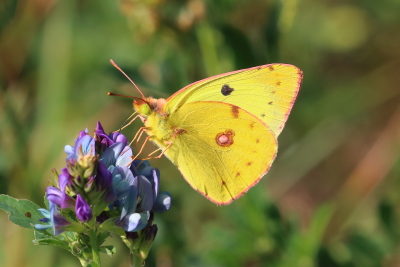
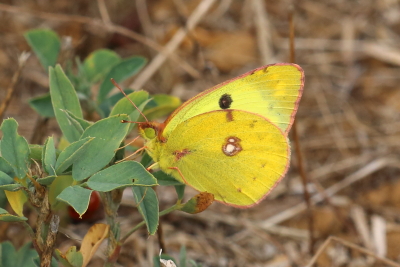
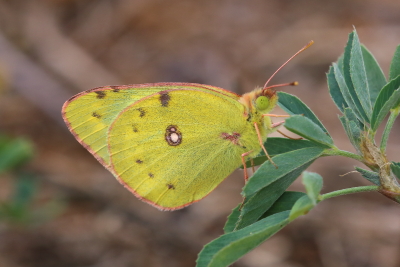
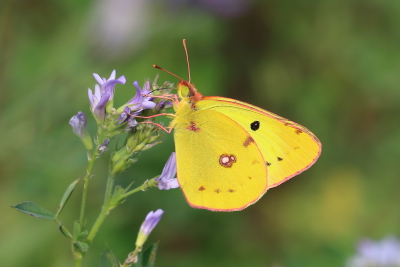
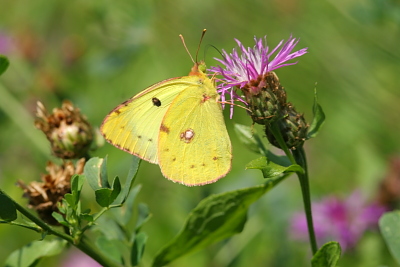
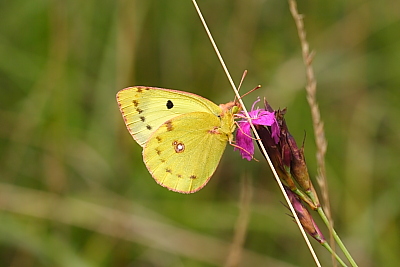
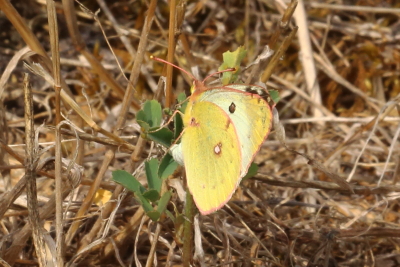
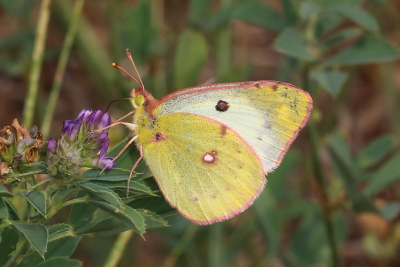
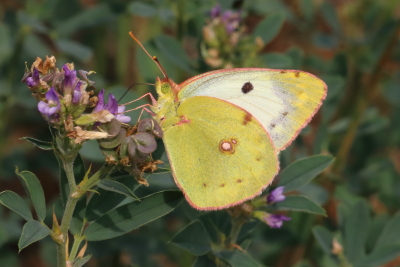
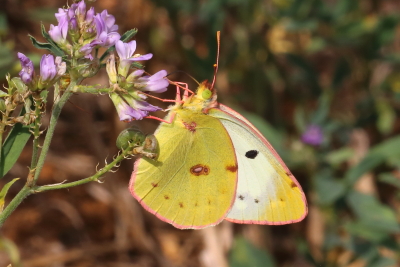
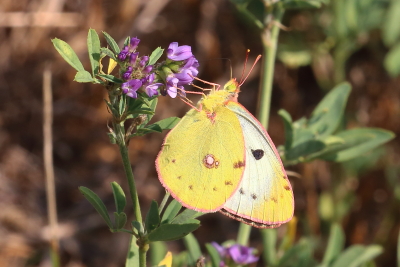
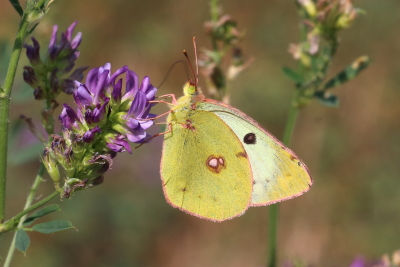
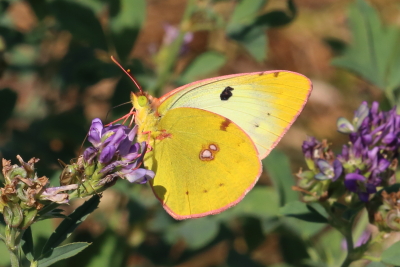
Pale Clouded Yellow (Colias hyale)
2024 photographs highlighted in yellow. Click on any photograph to go to an enlarged picture, or simply scroll down the page.
|
I have found hyale to be exceptionally elusive. It does not occur in Var where I spend most of my time in France, so I have little experience of it. There are records further north in the PACA region, although confusion with Berger's Clouded Yellow (C. alfacariensis) may well be a major factor in misidentifications, alfacariensis being widespread and common throughout the region. There are records shown in the Hautes-Alpes in the excellent PACA Atlas (https://naturographe-editions.fr/boutique/atlas-des-papillons-de-jour-et-zygenes/), and CEN-PACA, the publishers, have been assiduous in validating records.
Before 2022 I had photographs of what were most probably hyale, but none that were definitive. In late August 2022 I happened perchance to spot a field of Lucerne (Medicago sativa) in central France with several yellow butterflies flitting about in it. This was very promising as Lucerne is the larval hostplant, and hyale seems never to stray far from it. There were large numbers of hyale flying there, and I took photographs of as many as possible to get a feel for the variation in this species, making the assumption that they were all hyale and that some were not alfacariensis. I revisited this site in 2023 and it was still flourishing.
It is almost impossible to differentiate hyale and alfacariensis by external characteristics of the underside and they always have closed wings, and a view of the upperside is usually only visible during courtship.
In reality, the only totally sure method for identification is by the examination of male genitalia. I am of the opinion that this should only be undertaken in extremis for scientific studies where accurate identification is necessary, and not by enthusiasts that just wish to know and record what they have seen. Personally, I do not catch or interfere with any species.
I compared the 20+ images taken in August 2022, which I shall assume were all hyale, with 20+ images of alfacariensis, known to be such as they were photographed in Var, where hyale does not fly.
The larvae of these two species are different and in a recent study by Tim Cowles has bred them both from ova, comparing the larvae at each instar. Tim Cowles' study can be found here: http://www.european-butterflies.org.uk/downloads/EIG13.pdf
It seems to be less common than before. It is highly migratory and seems to move around, but the replacement of Lucerne as a crop by Maize may be a factor, and it may be that the Lucerne is harvested at the wrong time.
Females observed egg-laying may be the most reliable indicator: alfacariensis = mainly on Horseshoe Vetch (Hippocrepis comosa) or Crown Vetch (Coronilla varia). hyale = mainly on Lucerne, but also on White Clover (Trifolium repens)
The larval hostplants are different and the only completely reliable method of differentiating them (without capture and examination) is to observe the female egg-laying and identify the plant.
Location: where they were seen with reference to reliable distribution maps for each species. This is circumstantial and would only have credence if clearly outside the normal range for either species.
|
A review of (trusted) books and websites reveals a number of clues to identification (reference to the images shown in T&L may be necessary):
Colour of uph discal spot: only apparent from an upperside view alfacariensis = bright orange-yellow hyale = pale orange-yellow I only have one clear upperside image of either species, hyale 50342, and in this image it certainly appears that this spot is quite pale.
Degree of upf basal shading: only apparent from an upperside view alfacariensis = narrow, extending along the lower margin hyale = broader and extending further upward, along the costa. 50342 seems to tick this box as well.
Extent of uph black marginal mark: only apparent from an upperside view hyale = said to be stronger than alfacariensis
Smoothness of the internal edge of the upf apical mark: alfacariensis = said to be slightly less smooth than hyale
Curvature of forewing margin: alfacariensis = not straight, curved to some degree hyale = straight In the majority of the hyale I studied, the forewing margin was straight, a few had a slight curvature, and two (assuming they were hyale) had a more noticeable curvature. The reverse was true for alfacariensis in that nearly all had a greater or lesser degree of curvature and a few had straight margins. So, it appears this clue is a matter of probabilities, not an absolute rule.
Curvature or pointedness of forewing apex: alfacariensis = curved to some degree, not pointed hyale = quite noticeably pointed In the majority of the hyale I studied, the apex was quite pointed, a few had a slight curvature, and two (assuming they were hyale) had a more noticeable curvature – and they were the specimens that had some curvature of the margin. The reverse was true for alfacariensis in that nearly all had a greater or lesser degree of apical curvature and a few had quite pointed apices. So, like the straightness of the forewing margin, it appears this clue is a matter of probabilities, not an absolute rule.
Colour of unh: alfacariensis = said to be a brighter yellow than hyale There seemed to not be a lot of difference here.
Degree of grey scales on unh: alfacariensis = greater degree of grey scaling than hyale Both species were quite variable, but on balance the scaling of alfacariensis was greater, so there appears to some validity in this clue.
Colour of the surround of the unh white discal spot: This appears only to be referenced in the excellent new book on identification published by Gard Nature. hyale = slightly darker in colour than alfacariensis There seemed to be more consistency between specimens, but on balance the surround was darker for hyale.
In reality, there was no great consistency between the books and the features quoted were subject to some degree of variation. It is probably true to say that if it doesn’t have a straight margin and a pointed apex it is probably not hyale, but the converse is not always true as some known alfacariensis have straight margins and pointed apices. |
| ref | sex |
observations |
alt. m |
| 50342 | F | I think this is beyond doubt female hyale. The uph discal spot is fairly pale, not bright, the uph marginal band is quite strong and the basal shading extensive. | 280 |
| 38539 | F | this female is somewhat problematical. Is it hyale? The uph discoidal spot is clearly quite pale, but is this a result of ageing? The upf basal shading seems also seems to be quite extensive and thus ticking the box for hyale. I have a clearer shot of the male that is attending, and the uph discoidal spot seems more pale orange than bright orange. It may be significant that 38539 appears to be on Lucerne (Medicago sativa), the larval hostplant, and this is often the telling factor where females are concerned, and probably swings the balance in favour of hyale. It occurs to me now that maybe I should have observed it for longer, when it might have been kind enough to start egg-laying on this plant. | 320 |
| 50200 | M | a fresh male. The straightness of the margin and the pointedness of the apex, and the relative absence of grey scaling point (pun intended) clearly to hyale. | 280 |
| 50294 | M | a male. The forewing margin scores 100% for straightness and, although the apex has a very slight curvature, hyale is the strong favourite. | 280 |
| 50355 | M | a male with a little degree of wear. The margin and apex conform sufficiently to make hyale the favourite. | 280 |
| 50368 | M | I have labelled this a male, but the unf colour is rather a pale yellow, so it is possible it is a "yellow" female. However, on balance, I think it is just too yellow to be a female, and I am unaware of any mechanism to determine the sex. | 280 |
| 50387 | M | a male, with a slight but uncharacteristic degree of curvature of the margin. I think it's attraction to Lucerne and the company it was keeping make it more likely that it is hyale. | 280 |
| 51874 | M | a male, with a very straight margin and pointed apex. | 280 |
| 50422 | M | a male, with a very straight margin and quite pointed apex. | 280 |
| 50428 | M | a fresh male, with a straight margin and reasonably pointed apex. | 280 |
| 51886 | M | a male, with a fairly straight margin but a rather rounded apex. The colour is also a deeper yellow, so this could be a possible alfacariensis. | 280 |
| 2765 | M |
I believe this is a male hyale as the forewing outer margin is quite straight and the apex is maybe just about pointed enough for hyale. The ground colour is a pale lemon yellow indicating hyale. It was seen in northern Italy, where hyale does occur. |
600 |
| 27908 | M | this male was flying in the département of Côte-d'Or in central Eastern France where hyale does occur. I felt that the quite-clearly straight forewing margin and quite accentuated pointed apex would be good indicators of hyale, coupled with the rather pale yellow colouring (at least compared with the bright lemon yellow specimens prevalent in Var), but the opinion of at least one expert is that it is alfacariensis. However, if the straight margin and pointed apex do NOT indicate hyale, why are these characteristics quoted in identification books? | 320 |
| 50309 | F | a female, snapped in the act of egg-laying on Lucerne. 50320 is the same butterfly. | 280 |
| 50320 | F | a female, the same butterfly as 50309, showing the margin and apex indicative of hyale. | 280 |
| 50334 | F | a female, showing a little ageing, and slightly creamy-white unf colour. | 280 |
| 50363 | F | a female, with the expected unf slightly off-white colour. There is a very slight curvature to the margin. | 280 |
| 50372 | F | a female, very white unf colour and a degree of curvature to the margin and roundness of the apex, but still within range for hyale, I think. | 280 |
| 50396 | F | a female, with slight wear, and fairly typical of hyale. | 280 |
| 50404 | F | a very appealing fresh female, with a very clean pale yellow unf colour, a very straight margin and very pointed apex, although the camera angle may have accentuated this slightly. | 280 |
50342_female_Côte-d'Or_26Aug22
50309_female_Côte-d'Or_26Aug22
50320_female_Côte-d'Or_26Aug22
50334_female_Côte-d'Or_26Aug22
50363_female_Côte-d'Or_26Aug22
50372_female_Côte-d'Or_26Aug22
50396_female_Côte-d'Or_26Aug22
50404_female_Côte-d'Or_26Aug22